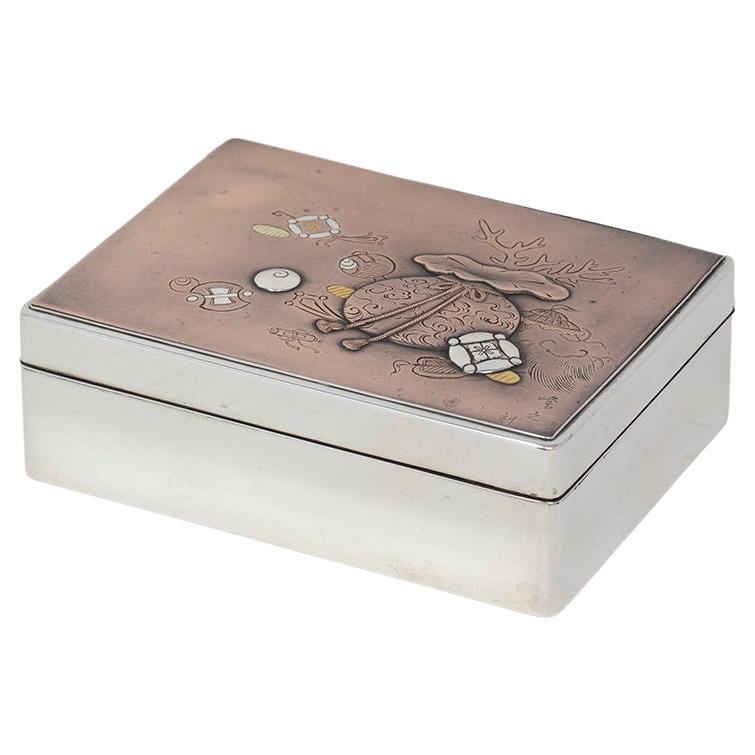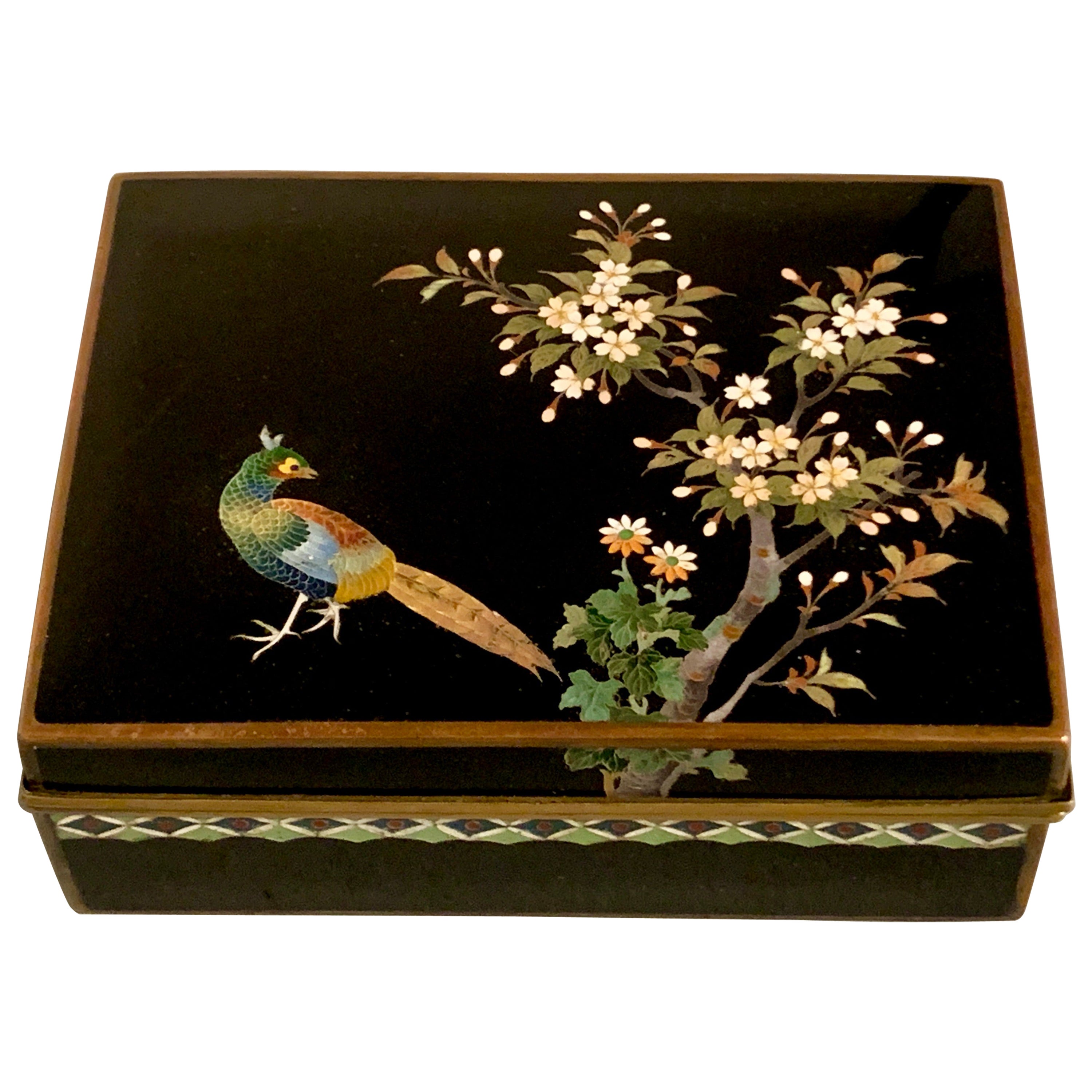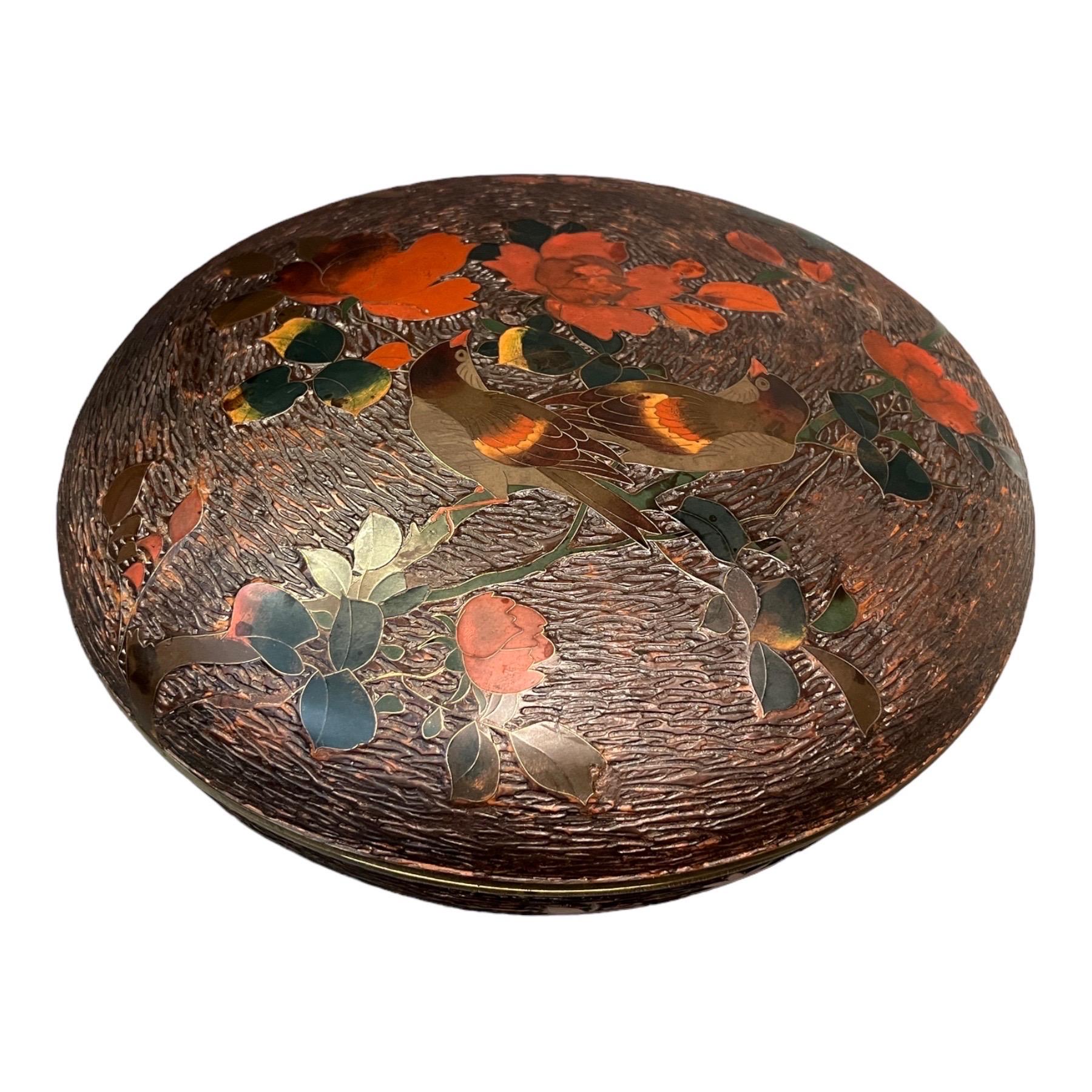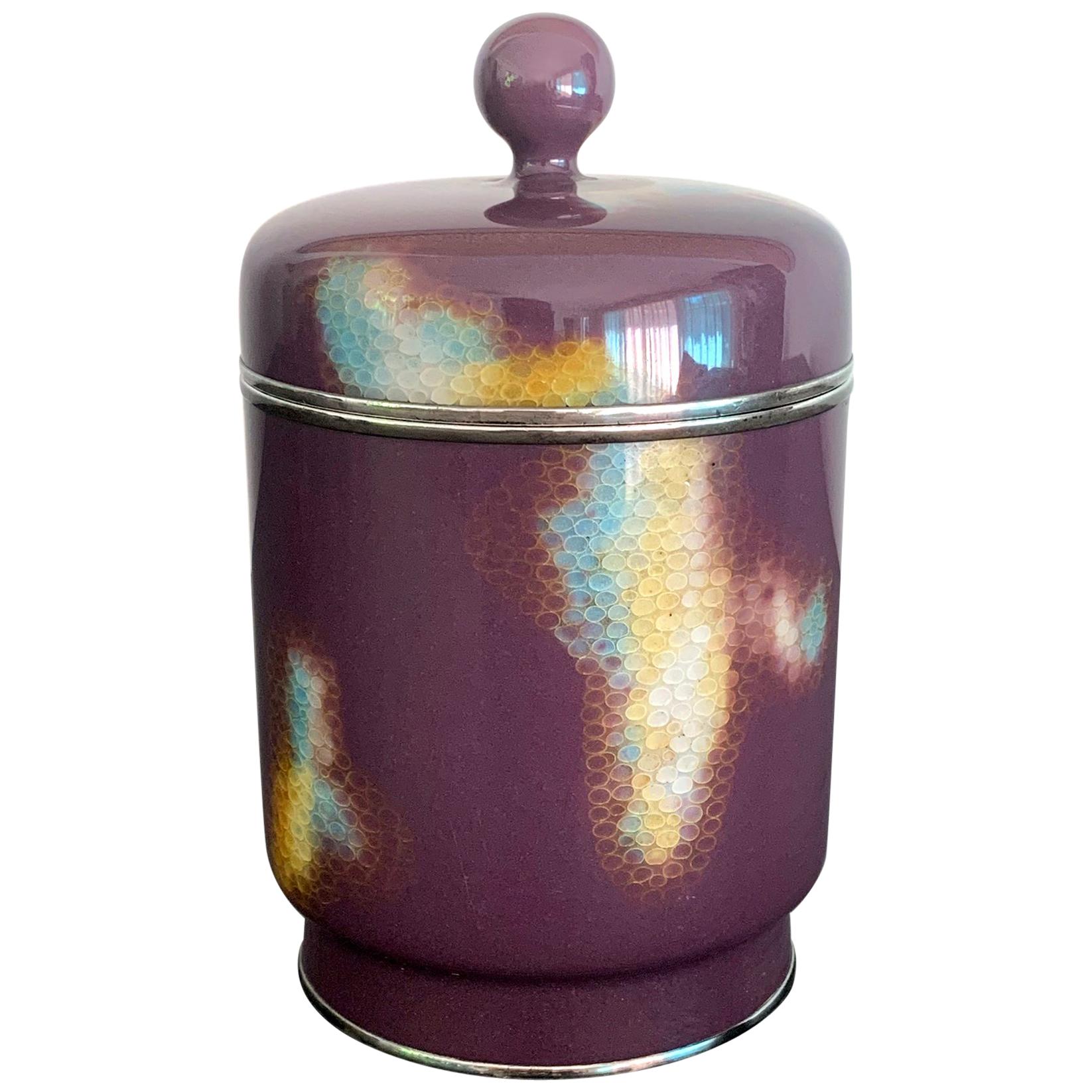Items Similar to Japanse Silver and Gold Bonbonniere by Mitsukoshi, Showa Era, 1935, Japan
Want more images or videos?
Request additional images or videos from the seller
1 of 14
Japanse Silver and Gold Bonbonniere by Mitsukoshi, Showa Era, 1935, Japan
About the Item
A small and delightful Japanese silver bonbonniere with an applied gold Imperial Chrysanthemum Seal, marked "jungin" and "Mitsukoshi", Showa Era, 1935, Japan.
This bonbonniere is recorded as having been commissioned for the Coming-of-age ceremony of Prince Takahiko (Prince Mikasa) under the Showa Emperor in 1935.
The small silver bonbonniere box and cover in the form of a tebako, a traditional box for personal items. The box designed in the ancient "mokko" shape, with rounded and indented corners, giving it a slight quatrefoil shape, symbolizing a stylized quince blossom, and thought to promote health and vitality.
The cover engraved with a scene of pine trees, stylized clouds, and an elegant Shinto torii gate. A gold sixteen petal chrysanthemum has been applied to the cover. The sixteen petal chrysanthemum is the symbol of the Emperor of Japan and the Imperial Family. It is referred to as the Imperial Seal of Japan or the Chrysanthemum Seal.
The sides of the box with half quatrefoil cutouts to the top, in order to accommodate the small ring handles with further sixteen petal chrysanthemums functioning as the mounts. The ring handles would originally have been fitted with a silk cord (now missing) to secure the box.
The underside of the box marked with "jungin" for pure silver (95%+ purity) and "Mitsukoshi". Mitsukoshi is a high end department store in Japan founded in 1905. They had strong relationship with the Imperial Family, supplying them with gifts and sundries.
Known as bonbonnieres, these small boxes, usually of silver, were used from the Meiji Period onwards as presentation boxes containing small gifts and keepsakes for visiting dignitaries and important guests. The Imperial Seal indicates this was a gift presented by the Emperor or Imperial Family.
Weight: 68.5 grams / 2.2 troy ounces.
- Creator:Mitsukoshi Ltd. (Manufacturer)
- Dimensions:Height: 0.63 in (1.61 cm)Width: 2 in (5.08 cm)Depth: 2.25 in (5.72 cm)
- Style:Showa (Of the Period)
- Materials and Techniques:
- Place of Origin:
- Period:
- Date of Manufacture:circa 1935
- Condition:Wear consistent with age and use. Minor surface scratches. Some remaining tarnish. Missing the silk cord.
- Seller Location:Austin, TX
- Reference Number:1stDibs: LU894733926282
About the Seller
5.0
Platinum Seller
These expertly vetted sellers are 1stDibs' most experienced sellers and are rated highest by our customers.
Established in 2001
1stDibs seller since 2010
306 sales on 1stDibs
Typical response time: 1 hour
- ShippingRetrieving quote...Ships From: Austin, TX
- Return PolicyA return for this item may be initiated within 7 days of delivery.
More From This SellerView All
- Japanese Silver Karabitsu Bonbonniere Box, Taisho Period, JapanLocated in Austin, TXA fine Japanese silver bonbonniere box in the shape of a karabitsu, Meiji Period, circa 1900, Japan. The small bonbonniere crafted of silver in the form of a karabitsu, a storage ...Category
Vintage 1920s Japanese Meiji Metalwork
MaterialsSilver, Sterling Silver
- Japanese Cloisonne Box by Inaba, Meiji Period, circa 1900, JapanBy Inaba Cloisonne Co.Located in Austin, TXA fine Japanese cloisonne hinged box with pheasant and autumn foliage, by Inaba Nanaho and the Inaba Cloisonne Company, Meiji period, circa 1900, ...Category
Antique Early 1900s Japanese Meiji Metalwork
MaterialsCopper, Enamel, Metal
- Nakajima Yasumi II Bronze "Tomoe" Ikebana Vase, Showa Era, 1960'sBy Nakajima Yasumi IILocated in Austin, TXA striking Japanese patinated bronze ikebana flower vase, "Tomoe", by Nakajima Yasumi II (1905 - 1986), Osaka, Japan. The highly sculptural vase is crafted of bronze with a spectacu...Category
Vintage 1960s Japanese Showa Metalwork
MaterialsBronze
- Nakajima Yasumi II Bronze "Keifuku" Ikebana Vase, Showa Era, 1960'sBy Nakajima Yasumi IILocated in Austin, TXAn elegant Japanese patinated bronze ikebana vase by Nakajima Yasumi II (1905 - 1986), circa 1960's, Osaka, Japan. The tall vase of graceful form, with a high round foot supporting ...Category
Vintage 1960s Japanese Showa Metalwork
MaterialsBronze
- Japanese Cloisonne Box, Meiji Period, Late 19th Century, JapanLocated in Austin, TXA very fine and intricately decorated Japanese cloisonné box and cover, Meiji period, late 19th century, Japan. The lidded trinket or jewelry...Category
Antique 1890s Japanese Meiji Metalwork
MaterialsBrass, Copper, Enamel
- Pair of Vintage Japanese Bronze Usubata, Showa, Mid-20th Century, JapanLocated in Austin, TXA striking and stylish pair of vintage Japanese cast and patinated bronze usubata, vessels for ikebana flower arranging, early to mid-20th century, Japa...Category
Mid-20th Century Japanese Showa Metalwork
MaterialsBronze
You May Also Like
- Japanese Meiji Period Silver Box Signed MasayukiLocated in Newark, EnglandJapanese Meiji period silver box with shibuichi plaque dating circa 1900. The box of rectangular form with a silver polished case stamped Jungin (J...Category
Antique Early 1900s Meiji Metalwork
MaterialsSilver
- Signed Japanese Steel Shakudo Damascene Box with a Shimazu MonLocated in Philadelphia, PAA fine antique 20th century Japanese Amita Damascene Steel Box. Made of damascened steel inlaid with gold & silver. The lid of the box has gilt depictions of bamboo plants, whi...Category
20th Century Japanese Showa Metalwork
MaterialsGold, Silver, Copper, Steel
- Large Japanese Cloisonné Box and Cover, Japan, Meiji Period, 19th CenturyLocated in PARIS, FRA rare Japanese bark tree large cloisonné box on metal from the Meiji period. Usually bark tree cloisonné was on porcelain (totai Shippo) A very attracti...Category
Antique Late 19th Century Japanese Metalwork
MaterialsMetal
- Japanese Cloisonné Covered Jar by Ando JubeiBy Ando JubeiLocated in Atlanta, GAJapanese cloisonné enamels are known as shippo-yaki and the mid-19th century saw the production of very high quality wares in the early centers Nagoya. One of the most renowned works...Category
Early 20th Century Japanese Japonisme Metalwork
MaterialsMetal, Sterling Silver, Enamel
- Japanese Cloisonné Jewelry Presentation Box Japan Racing AssociationLocated in New York, NYVery rare Japanese cloisonné jewelry box, circa 1960s. Rich floral design top on white enamel background. Garnet velvet interior , with tray. B...Category
20th Century Japanese Anglo-Japanese Jewelry Boxes
MaterialsBronze
- Japanese Bronze and Mixed Metal Box, Signed To Base, Meiji PeriodLocated in Melbourne, VictoriaA rare Japanese Meiji period (1868 - 1912) circular bronze box and cover by Inoue, Kyoto, late 19th century. The cover embossed with gilt, silvered and coppered decoration of inse...Category
Antique Late 19th Century Japanese Metalwork
MaterialsBronze
Recently Viewed
View AllMore Ways To Browse
Sterling Silver Bonbonniere
Gold Bonbonniere
Cast Iron Japanese Tea Kettles
Antique Cast Iron Water Kettle
Cloisonne Fish Bowl
Japanese Chocolate Set Antique
Antique Sprinkler Bottles
Champleve Censer
Tiffany China Bowl
Yemeni Jambiya
Antique Japanese Saki
Chinese Dragon Costume
Vintage Arabic Coffee Pot
Antique Indian Spice Tin
Brass Rose Water Sprinkler
Chinese Copper Teapot
India 19th Century Hand Etched Brass Vase
Japanese Belt Buckle





